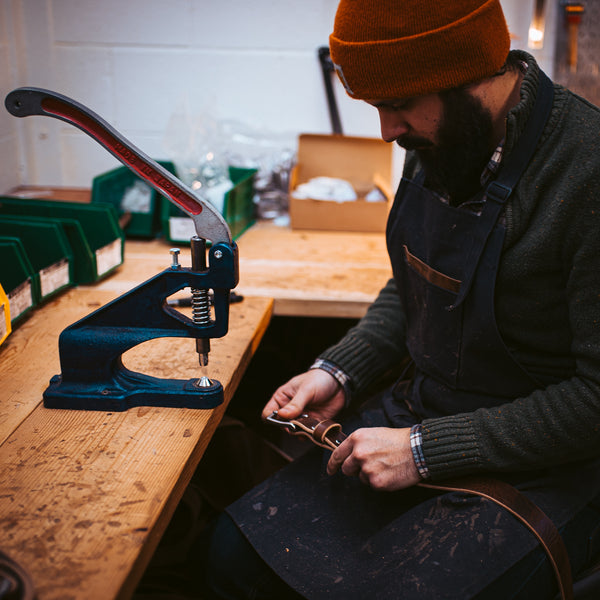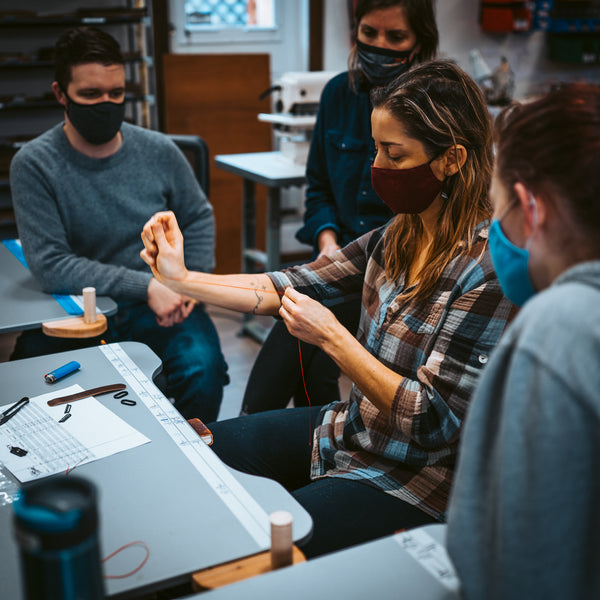Did you know that Junyuan Bags started out in a kitchen?
Ryan Popov — now the owner and CEO of Junyuan Bags — wasn’t trying to build a business when he started. He was just trying to create a flat leather wallet that suited his needs. He picked up a leatherworking kit in 2013 and set out to craft that one specific thing.
Then, as he pored over bits of scrap leather, creating his design, something happened. His interest blossomed into a passion for leatherworking. When his wife, Jill, suggested that others might enjoy his finished product, he put some feelers out. Before long, Junyuan Bags was born.
But what does any of that have to do with you?
It proves that anyone can pick up leatherworking as a hobby. And with time and dedication, that hobby can grow into something constructive. As you learn to work with leather, you can create unique clothing pieces and products that you love.
In this comprehensive, step-by-step leatherworking guide, you’ll learn everything you need to know to begin your journey. Discover for yourself whether you, too, have a passion for leatherworking.
Step 1: Buy the necessary leatherworking tools
Professional leather workers use a wide variety of (often expensive) tools. But that doesn’t mean that you need to invest your savings account into your new hobby. You can hold out on purchasing a myriad of awls or high-end groovers until you’re certain that leatherworking is the hobby for you.
When you’re first getting started, you only need a few basic tools:
- Scissors
- Harness Needles
- Thread
- A sturdy knife
- A cutting mat
- A rubber mallet
- A diamond chisel
- A scratch awl
As you continue working with leather, you may decide to invest in other tools — such as a stitching pony or burnishing kit — to take on more complex tasks. But at first, it’s perfectly acceptable to have a small leatherworking tool kit at your disposal.
Step 2: Get to know basic leatherworking skills

You don’t need to invest in pounds of certified Horween leather to start practicing leatherworking. Just as stone carvers may begin with more pliable materials, like soap, leatherworkers often hone their craft by practicing basic leatherworking skills on budget-friendly materials, including scrap leather or synthetic leather.
Once you’ve practiced your leatherworking skills, you can move on to high-quality leathers with confidence.
Different leathers may require subtle changes to your techniques. For example, leather made from a lamb is much thinner than leather made from a cow. As a result, you may need to use a firmer hand when working with cowhide leather, whereas you may need less glue when working with lambskin leather.
This means that even if you master a leatherworking skill with one type of leather, you may make blunders when you start working with new materials. That’s normal! Keep at it, and you’ll eventually learn to feel the leather you’re working with and adjust your techniques accordingly.
Cutting your leather
The first step in any leatherworking project is to trace your template on your chosen leather and cut it out.
This step may seem straightforward. But keep in mind that the quality of your leather cuts can make or break the rest of your project. If you have uneven lines or ragged cuts, no amount of skilled saddle stitching will save your project. For that reason, you should always use a ruler when you’re first drawing out your template. This ensures that the sizes of your pieces are precise.
When it’s time to cut your template out, consider scoring it before you cut it. This can help you make smooth, clean cuts.
But the most important thing you need to remember is to use sharp blades. Using a sharp knife reduces your chances of hurting yourself. When your knife is sharp, you don’t have to apply as much pressure to the blade and have more control over your cuts.
Gluing your leather
Gluing pieces of leather together is a straightforward process. The most important thing to know is to only use glue specifically created for leatherworking.
Your leatherworking template should specify which pieces of leather you need to glue. One pro tip is to rough the edges that you’re going to piece together. This helps the glue adhere and prevents slippage. Meanwhile, using a glue spreader can help you get an even layer. This will prevent bumps in your final product.
Once you’ve spread your glue on the right pieces of leather, leave the project to dry overnight. This can take 6-10 hours. It’s usually safest to leave your items to dry overnight.
Stitching your leather
At the heart of leatherworking is the stitch you use. The most common stitch for leatherworking is the saddle stitch. This special type of hand-stitching requires harness needles and waxed thread. By hand-stitching in this specific way, you can create a sturdy seam.
Video tutorials like the one above can help you master this technique.
Finishing your edges
Finishing your edges elevates your final leatherworking project. It transforms a typical DIY leather project into something polished and professional-looking.
One of the best ways to finish your edges is through a process called burnishing. To burnish the edges of your project, start by taking a damp cloth and running it along the edges. This pre-burnishes them, making the leather supple and ready to be worked.
Once you’ve dampened your edges, rub a hand burnishing tool back and forth across the edges. Keep doing this until they’ve taken on a glossy sheen and are smooth to your touch.
Step 3: Choose your first leatherworking project
Here’s the hard truth: no matter how much you prepare, your first leatherworking project is probably going to look awful.
Your second and third attempts might not look great, either. Working with leather is an art form, and it takes practice to get your rivets to lay flat or your stitching to hold together well.
But knowing that your first leather projects won’t be amazing shouldn’t stop you from trying. Instead, start with small projects you won’t be upset if you mess up.
Once you master small leather making kits, you can move your way up the rung. Soon, you’ll be following patterns, and if you stick with it, designing your own unique projects.
Some ideas for starter leatherworking projects include:
- Leather sunglasses case
- Leather lighter sleeve
- Leather card holder
- Leather passport cover
Although you can rotate your starting projects, you may have more luck if you purchase the same kit repeatedly. Science shows that repetition helps you learn new skills faster. By repeating the same pattern, you can help your brain build the pathways it needs to improve your leatherworking skills. Once you master one kit, you can move on to another kit.
Step 4: Learn more by observing others

Social media platforms can be wonderful things. Artisans no longer have to teach themselves techniques without feedback. Today, you can watch leatherworkers hone their craft on TikTok or follow along with DIY tutorials on Youtube.
Watching other people work with leather can give you new ideas for leatherworking techniques. You might notice how certain leatherworkers adjust their hold on leather when they’re burnishing it. Or you might note how they manage to keep their seams flat. Observing other artisans can help you hone your craft faster than if you tried to figure it all out on your own.
YouTube videos can also give you unique ideas about things you can make with leather outside of typical DIY kits. For example, many people are having luck making leather earrings right now.
The benefits of watching other leatherworkers don’t end once you master your basic skills, either. As you advance, other artisans can give you an idea of which tools are worth investing in and what each of those tools can do for your craftsmanship.
Hone your craft and create your dream leather projects
From the sweet smell of leather in your workshop to the buttery feel of it against your fingertips, working with leather has an unbeatable allure. But in addition to being a soothing hobby, leatherworking has practical uses. You don’t have to limit yourself to the leather products you see in stores or online. By learning to work with leather on your own, you can create new designs perfect for you as an individual. You can also create one-of-a-kind gifts for the people in your life to enjoy.
The best part of all is that there is a low barrier to entry. Anyone can start working with leather at any time. DIY kits make it easier than ever to jump into the world of leathermaking. At the end of the day, what sets a skilled leathermaker apart from a hobbyist is dedication, practice, and passion.
Do you have what it takes?
Junyuan Bags | Professional Bag Manufacturer
Ten articles before and after
6 Top EDC Items: The Must Have List for Beginners – Junyuan Bags
9 Essential Everyday Carry Items for Every Man – Junyuan Bags
A Quick Leather Thickness Chart and Handy Guide – Junyuan Bags
Aniline Leather: What Is It and How Is It Different? – Junyuan Bags
What’s the Best Wallet for You? Cardholders vs Bifold vs Trifold Walle – Junyuan Bags
3 Times When Carrying a Card Holder Is Better Than a Bulky Wallet – Junyuan Bags
Leather: Like a Fine Wine – Junyuan Bags
Personalized Wallets: 2 Ways to Make Your Wallet Uniquely Yours – Junyuan Bags




 Mobile/What's App/Wechat
Mobile/What's App/Wechat E-Mail
E-Mail ADD
ADD




